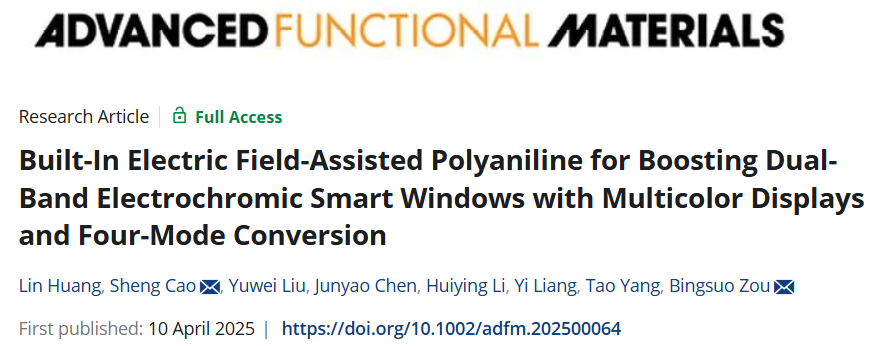Recently, the nanophotonics research team of GXU has achieved a breakthrough in dual-band electrochromic smart window technology. Their study, titled "Built-In Electric Field-Assisted Polyaniline for Boosting Dual-Band Electrochromic Smart Windows with Multicolor Displays and Four-Mode Conversion," was published in the internationally renowned journal Advanced Functional Materials. The paper's first author is Huang Lin, a 2022 master's student from the School of Physical Science and Engineering Technology, with corresponding authors being Professor Cao Sheng from the same school and Professor Zou Bingsuo from the School of Resources, Environment, and Materials. Guangxi University is listed as the sole corresponding affiliation.

Building energy consumption accounts for approximately 30% of global energy use and contributes to about 10% of global greenhouse gas emissions, primarily from heating and cooling systems. In Guangxi, a subtropical region characterized by hot, humid climates and intense sunlight, controlling building energy consumption poses even greater challenges. Electrochromic smart windows, capable of dynamically regulating solar transmission, show immense potential in reducing energy consumption. Dual-band electrochromic technology, in particular, has emerged as a research hot spot in green building design due to its ability to selectively modulate visible and near-infrared (NIR) light transmittance, enabling coordinated optimization of lighting and thermal management. However, existing dual-band systems face bottlenecks such as difficulty in independently controlling visible and NIR light and limited color diversity, hindering their widespread adoption in diverse applications.
To address these challenges, the team developed a novel dual-band electrochromic smart window featuring multicolor displays and four-mode optical switching, achieving independent regulation of visible and NIR light transmission. The study utilized polyaniline (PANI), a common electrochromic material whose optical properties depend on polaron and bipolaron formation mechanisms. By introducing gold nanoparticles to form an Au/PANI Schottky junction, the researchers established a built-in electric field that precisely regulates polaron and bipolaron generation, significantly enhancing selective absorption of visible and NIR light. The fabricated smart window enables flexible switching among four modes: Bright (fully transparent), Cool (NIR-blocking), Dark (dual-blocking of visible and NIR light), and Warm (visible light-blocking), offering an ideal solution for diverse climatic and application requirements. This research not only deepens the understanding of PANI’s electrochromic mechanisms but also provides technical insights for smart building systems in high-temperature, high-humidity environments, paving the way for advancing China's "Dual Carbon" goals.
This achievement marks another milestone following the team's previous breakthrough in constructing multi-color four-mode dual-band electrochromic smart windows using an asymmetric device architecture.